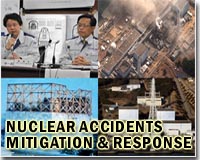| . |  |
. |
Tokyo (AFP) May 22, 2011 Tokyo Electric Power's belated admission that damage to crippled reactors at its nuclear plant is worse than it first thought has fuelled suspicion it withheld bad news in the first days of Japan's crisis. A series of revisions to earlier assessments about damage to the Fukushima Daiichi nuclear plant have emerged since the utility began sending workers into reactor buildings for the first time. More than two months after the worst nuclear disaster since Chernobyl was triggered, TEPCO last week admitted fuel rods inside reactor cores melted down in the first few hours after the March 11 tsunami disabled cooling systems. It was a sharp reversal of earlier assessments from both TEPCO and the government that meltdown was unlikely, reactors were relatively stable and dangerous radiation leaks had been largely contained. Prime Minister Naoto Kan conceded that the government failed to see flaws in TEPCO's earlier assumptions and has called for a regulatory overhaul. "What I told the public was fundamentally wrong," Kan told a parliament session Friday. "We failed to respond to TEPCO's mistaken assumptions. I am deeply sorry," he said. TEPCO said it had revised earlier information only after it could send workers close enough to the reactors to read gauges but critics argue that independent experts reached similar conclusions much earlier. "The way TEPCO releases information utterly lacks any sense of crisis," the Nikkei business daily said in a recent front-page analysis. "Two months after the accident happened, it admitted a meltdown at reactor one. But many experts pointed out that possibility immediately after the accident happened," the newspaper said. "They do not mention bad news until it is confirmed. Such an attitude has led to mistrust," the Nikkei said. The biggest utility in Asia, TEPCO is a regional monopoly supplying power to Tokyo and its surrounding Kanto region in central Japan. With a track record of safety cover-ups, TEPCO has been criticised for inadequately preparing for disaster, helped by soft regulation by a government organisation also tasked with promoting nuclear power. The liberal Asahi Shimbun said in an editorial that TEPCO and official regulators avoided direct reference to the term "meltdown" to "lead the public into underestimating what was really happening." Public anger and confusion have intensified, and critics say the latest revisions underline the slowness of moves to ensure the safety of nearby residents. Shortly after the emergency began, the government asked those living within a three-kilometre (two-mile) radius from the plant to evacuate as a precaution. The government and TEPCO gradually expanded the evacuation area to 20 kilometres as the plant continued to release radioactive materials, and recommended those between 20-30 kilometres stay indoors. Last week it started moving people from towns beyond the zone, with tens of thousands of people having had to flee their homes. Even after hydrogen explosions blew away concrete buildings that housed reactors, officials maintained that the reactors themselves had remained intact, posing a relatively low "immediate" risk to health. It was later learned that massive radiation leaks peaked around the time of the explosions in the first few days, while many nearby residents still remained at home. Fukushima Daiichi is believed to have released a 10th of the material emitted by the Chernobyl plant in 1986, but the situation has not yet been resolved. The Atomic Energy Society of Japan, a nationwide conference of nuclear scientists, said in a report that TEPCO and authorities failed to adequately explain the situation. "Radiation safety is complex and difficult to understand," the society said. "The logic behind radiation's effects on human health... was not accurately communicated, inviting unnecessary confusions," it said. "(The authorities) are seen holding back information and have lost credibility," it said. In the wake of the disaster, TEPCO posted the biggest loss in Japanese corporate history for a non-financial firm and its president Masataki Shimizu stepped down. "More can be done to think about our customers," he said of his company's inward looking corporate culture on Friday. Compensation is expected to hit as much as 10 trillion yen ($123 billion). No one has yet died as a result of radiation exposure, but Fukushima residents have voiced worries about long-term health effects amid scepticism that TEPCO can honour its pledge to end the crisis by January.
Share This Article With Planet Earth
Related Links Bringing Order To A World Of Disasters A world of storm and tempest When the Earth Quakes
 Leaders of Japan, China, S. Korea meet in Fukushima
Leaders of Japan, China, S. Korea meet in FukushimaTokyo (AFP) May 21, 2011 Leaders of Japan, China and South Korea were to gather in Fukushima City Saturday in a gesture of solidarity over the ongoing nuclear crisis - but with Tokyo's neighbours reportedly concerned by its actions. Ahead of a three-way summit, Japan's Prime Minister Naoto Kan, Chinese Premier Wen Jiabao and South Korean President Lee Myung-Bak are to visit evacuees who have left their homes near ... read more |
|
| The content herein, unless otherwise known to be public domain, are Copyright 1995-2010 - SpaceDaily. AFP and UPI Wire Stories are copyright Agence France-Presse and United Press International. ESA Portal Reports are copyright European Space Agency. All NASA sourced material is public domain. Additional copyrights may apply in whole or part to other bona fide parties. Advertising does not imply endorsement,agreement or approval of any opinions, statements or information provided by SpaceDaily on any Web page published or hosted by SpaceDaily. Privacy Statement |